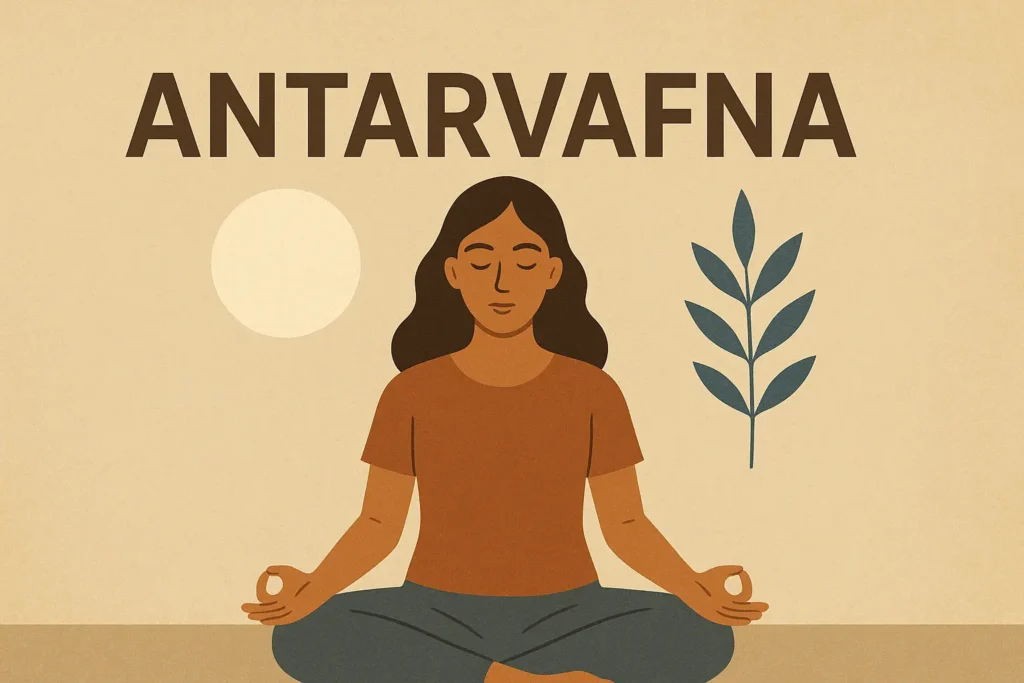Modern life pulls attention in a hundred directions at once, yet the deepest answers often appear when attention turns inward. That turning is what many people describe with the word antarvafna: the simple, disciplined act of watching the flow of thoughts, sensations, and emotions without trying to steer them. Instead of forcing calm, you invite clarity. Instead of arguing with the mind, you listen. Practiced regularly, antarvafna helps you see patterns that run your day in the background and gives you the space to choose a wiser response.
What It Means in Everyday Terms
Think of it as inner observation. The simplest way to describe antarvafna is “sit, notice, and let things be as they are.” You are not emptying your mind. You are learning how it works when you stop pushing and pulling. With gentle attention, you watch beliefs rise, feelings swell, and impulses pass. Over time, this reveals triggers, habits, and hidden assumptions you didn’t know were driving decisions.
Where the Idea Comes From
Across many reflective traditions you’ll find practices of quiet self-inquiry and mindful witnessing. While the exact word antarvafna is modern in usage, the spirit behind it echoes ancient habits: sitting in silence, noticing the breath, tracing a feeling to its root, and returning to present experience without judgment. The point is not dogma; it is direct experience—your own mind, seen clearly.
Why It’s Different from Common Meditation
Many guided techniques ask you to focus on a single object, like the breath or a mantra. By contrast, antarvafna invites a relaxed, panoramic awareness. Thoughts wander, and that is welcome. The practice is to stay with whatever appears, including restlessness, boredom, or frustration. Unlike breath-focused meditation, antarvafna encourages you to observe the mind’s natural movement and learn from it rather than redirect it.
Benefits You Can Feel
People often report steadier moods, better emotional regulation, and a noticeable pause between stimulus and reaction. That pause is powerful: it lets you respond thoughtfully instead of reflexively. Relationships benefit because you catch your own stories before you project them. Work sharpens because attention is less fragmented. Sleep improves as rumination loses its grip. With regularity, antarvafna supports resilience, clearer priorities, and a quieter nervous system.
Core Principles to Keep You Grounded
Go in with non-judgment, because judging the mind for being busy only makes it busier. Bring curiosity, the kind you’d offer a close friend. Keep sessions short at first and consistent, because consistency turns antarvafna from a concept into a reflex. Stay embodied: notice breath, posture, and small shifts in your chest or jaw so the practice doesn’t drift into abstract thinking.
A Simple Practice You Can Start Today
Choose a quiet spot and set a gentle timer for ten minutes. Sit upright, hands relaxed. Let the eyes soften or close. Notice whatever is most obvious: a sensation, a sound, a thought. Name it softly in your mind—“warmth,” “planning,” “tightness”—then let it pass without chasing it. If emotions swell, feel where they land in the body and breathe there. When you drift into stories, simply note “thinking” and return to raw experience. Try a ten-minute antarvafna session like this for a week and observe how your baseline reactivity changes in daily life.
Bringing It Into Daily Life
Formal sitting is only half the picture. Bring antarvafna into real moments: a tense email, a family disagreement, the urge to scroll late at night. Pause for a single breath, name what is present, and ask, “What is the kindest helpful next step?” That tiny check-in rewires habits faster than occasional long sessions. Over lunch, take one minute to notice taste and breath; during a commute, feel your feet and the rhythm of walking. Repetition in ordinary moments builds quiet strength.
Working with Difficult Emotions
Strong feelings are not obstacles; they are teachers. When irritation or sadness appears, widen your attention to include posture, breath, and the urge to act. A common pitfall is trying to fix the feeling immediately. In antarvafna you slow down first, sense where the body tightens, and let the wave crest and settle. Insight often follows in the calm after the surge.
Measuring Progress Without Turning It Into a Test
You will not get a certificate for inner clarity, so use simple indicators: shorter recovery time after stress, kinder self-talk, fewer impulsive replies, and a clearer sense of priorities. If you skip days, resume without drama. Progress in antarvafna shows up most obviously in how you live, not in how perfect your sessions feel.
A Seven-Day Starter Plan
Day 1–2: five to seven minutes of quiet sitting, noticing breath and body.
Day 3–4: keep the same practice and add one one-minute pause before lunch and before bed.
Day 5–6: extend to ten minutes; journal a few lines about what you noticed.
Day 7: keep ten minutes and bring the practice to a real challenge—an email, a call, a craving. Reflect briefly on what changed.
Common Mistakes and Gentle Corrections
Trying to eliminate thoughts usually backfires. Instead, treat thoughts as weather passing across a big sky. Forcing a particular state creates tension; let curiosity lead. Skipping practice after a hard day is tempting, but that is the best time to sit. If restlessness dominates, open your eyes, sit a little taller, and include sounds and touch in your field of attention.
Who Benefits Most
Anyone navigating high pressure, creative work, caregiving, or study can use this. Leaders learn to respond rather than react. Parents gain patience. Students build focus. Creatives access flow more reliably because they understand the mind’s rhythms and can ride them instead of resisting them.
Putting the Practice in Context
Inner work is not a substitute for practical action. Use the clarity gained through antarvafna to set boundaries, have honest conversations, and make concrete changes. Insight without follow-through fades. When practiced patiently, antarvafna becomes a reliable way to reconnect with what matters and to act from a steadier place.
Conclusion
Life doesn’t slow down on its own; attention must learn to stand still inside it. With steady practice, antarvafna reveals how thoughts and feelings rise and fall, loosens unhelpful patterns, and restores a calm center you can trust. The aim is not perfection; it is presence. Over weeks and months the benefits compound into clearer choices, kinder relationships, and a quieter mind that can meet the day with ease.
FAQs
What is the basic idea behind this practice?
It is a method of inner observation where you sit quietly, notice thoughts and sensations, and let them pass without judgment. The goal is clarity, not control.
How long should a beginner practice each day?
Start with five to ten minutes. Short, consistent sessions build more momentum than occasional long sits, and results show up in daily reactions.
What if my mind won’t stop racing?
Racing is fine. Label what you notice—“thinking,” “worrying,” “planning”—and return to raw sensations like breath or posture. Gentleness works better than force.
Can this help with stress and decision-making?
Yes. By creating a small pause between trigger and response, you make choices from clarity rather than from habit, which lowers stress and improves outcomes.
Do I need special tools or a teacher?
A quiet space and a timer are enough to begin. Guidance can be useful, but consistent practice is what makes the difference over time.

